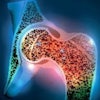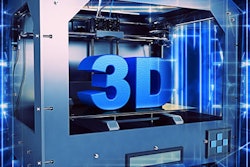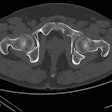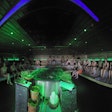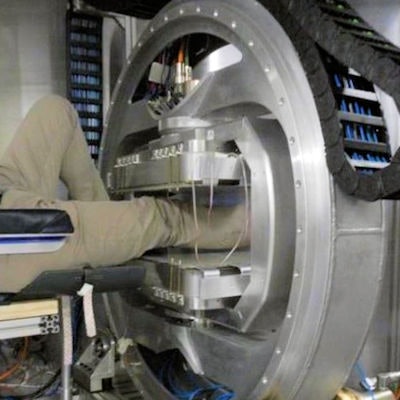
Researchers at Imperial College London have developed a prototype mini-MRI scanner that fits around a patient's leg and could quickly and accurately diagnose knee injuries. The small-scale device could help diagnose conditions such as anterior cruciate ligament injuries, which are particularly common among footballers, or be used in local clinics and surgeries to reduce waiting times for MRI scans.
Knee injuries affect millions of people, and MRI scans are crucial to establish which part of the joint is injured. Knee injuries commonly affect either the tendons, meniscus, or ligaments. However, these structures are not usually visible with MRI due to the way that water molecules are arranged in such areas.
"These structures are normally black on an MRI scan -- they simply don't produce much signal that can be detected by the machine to create the image. This is because they are made mostly of the protein collagen, arranged as fibers," explained Karyn Chappell, MRI research radiographer and doctoral student at Imperial's Musculoskeletal Lab. "The collagen fibers hold water molecules in a tight configuration, and it is in fact water that is detected by the MRI. If you do see a signal, it suggests there is more fluid in the area, which suggests damage, but it is very difficult for medical staff to conclusively say if there is injury."
To overcome this problem, Chappell plans to exploit the "magic angle" effect, in which the brightness of tissues such as tendons and ligaments in MR images strongly depends on the angle between the collagen fibers and the scanner's magnetic field. If this angle is 55°, the image can be very bright, but for other angles, it is usually very dark.
The magic angle is easily achieved in the mini-MRI scanner by changing the orientation of the magnetic field. While the patient sits in a chair, a specially designed magnet rotates around the leg and orientates the magnetic field in multiple directions.
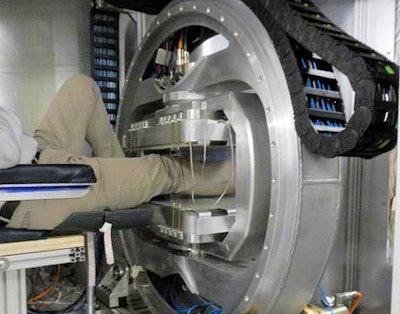 The prototype mini-MRI scanner could be used for diagnosing knee injuries. Image courtesy of Imperial College London/Magnetic Resonance in Medicine.
The prototype mini-MRI scanner could be used for diagnosing knee injuries. Image courtesy of Imperial College London/Magnetic Resonance in Medicine."Previously, the magic angle phenomenon was thought of as a problem, as it could mean medical staff mistakenly thinking the knee is injured," Chappell said. "However, I realized that if we took a number of scans around the knee, we could use the signal produced by the magic angle effect to build a clear picture of the knee structures."
"Specifically, we can combine images obtained at different magnet angles, and not only increase the brightness but also see how the collagen fibers are arranged," she explained. "This enables us to establish the pattern of collagen fibers in the knee structures, which is crucial information ahead of treatments such as repairing a torn meniscus."
To determine the feasibility of magic angle scanning, the team used a conventional MRI scanner to scan the knee joints of six goats and 10 dogs at various orientations to the main magnetic field. The group saw that MRI scans using the magic angle could accurately detect ligament and tendon damage (Magn Reson Med, 12 May 2019).
Having demonstrated that magic angle scanning can visualize the knee, the researchers now plan to combine this approach with their prototype miniscanner. They hope to progress to human trials of the miniscanner within a year.
"Although this is an early-stage proof-of-concept study, it shows the technology could potentially be used to accurately detect knee injury. We now hope to enter human trials -- and explore if this technology could be used for other joints such as ankles, wrists, and elbows," Chappell explained.
Tami Freeman is the medical and biophysics editor for Physics World.
© IOP Publishing Limited. Republished with permission from Physics World, a website that helps scientists working in academic and industrial research stay up to date with the latest breakthroughs in physics and interdisciplinary science.



